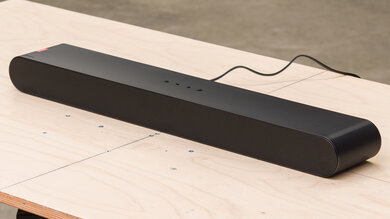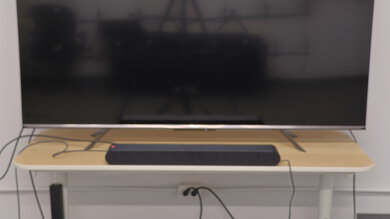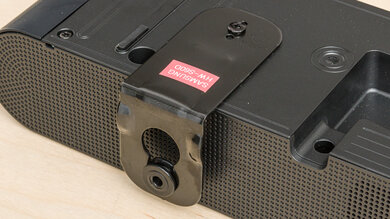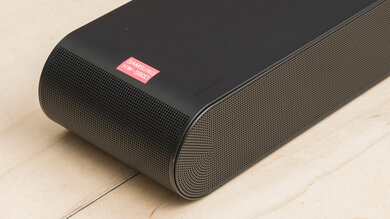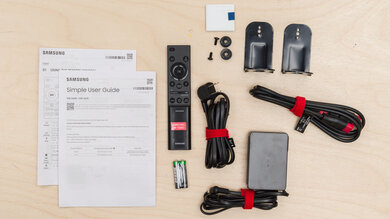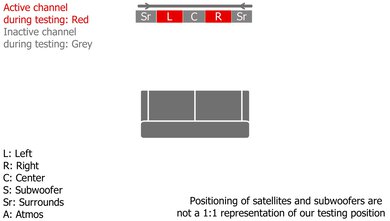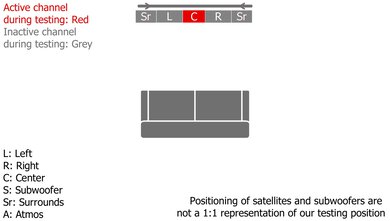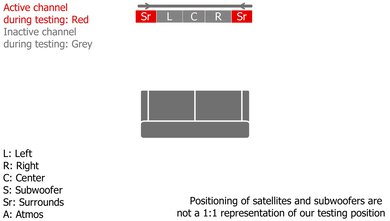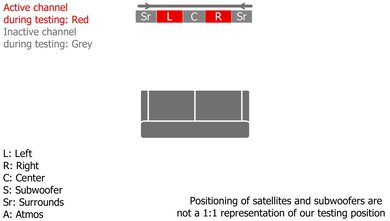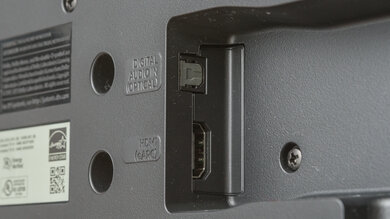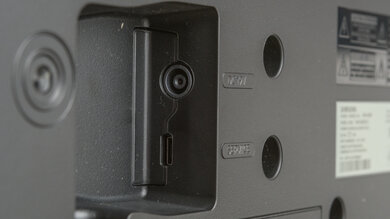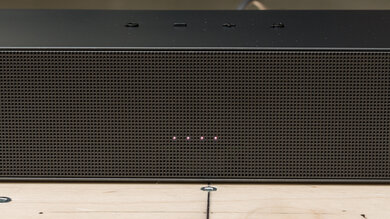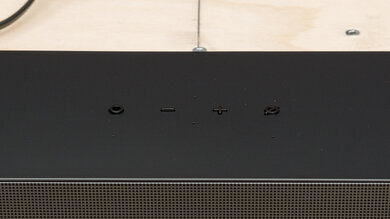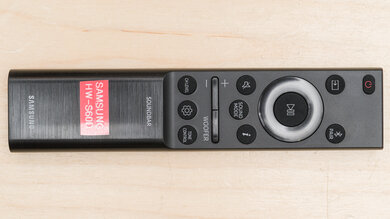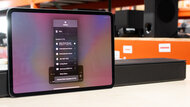The Samsung HW-S60D is a 5.0, all-in-one soundbar released in 2024. It's the next generation of the Samsung HW-S60B/S61B. While the design and core features of the bar remain unchanged, this new iteration adds an HDMI eARC connection and built-in Chromecast support. Let's see if these small changes are enough to cement its place as one of the best budget all-in-one bars.
Our Verdict
The Samsung HW-S60D is decent for mixed usage. It has a relatively balanced sound out-of-the-box, with a boost in the high-bass that compensates somewhat for the lack of low-bass. This is to be expected with a standalone bar, though, and the attack of kick drums and basslines is still audible. The mid-range is well-balanced and, paired with a discrete center channel, makes for a clear and detailed reproduction of dialogue and vocals. It has a reasonably wide, immersive soundstage, too, and can get loud enough to fill the average living room. The wide array of sound enhancement features, including the SpaceFit Sound room correction tool, means that this bar is versatile enough to be used for movies, TV, or bumping tunes at home.
-
Dolby Atmos, DTS support
-
Graphic EQ and presets.
-
Room correction tool.
-
Lacks low-bass.
-
No upfiring drivers for height in Atmos content.
-
Sub-par surround performance.
The Samsung S60D is great for dialogue and TV shows. Its discrete center channel helps you localize dialogue easily, and the balanced frequency response (both in the center and the bar as a whole) ensures speech is clearly discernable. The bar gets loud enough to fill the average living room with sound, and there's not much compression in the mid-range at max volume that can interfere with speech clarity. You can also choose between the Active Voice Amplifier and Voice Enhancement sound modes if you want to ensure dialogue remains at the forefront.
-
Graphic EQ and presets.
-
Built-in Chromecast support.
-
Great center channel performance.
-
Lacks low-bass.
-
Sub-par surround performance.
The Samsung S60D is good for music. While its bass response doesn't extend too low without a dedicated subwoofer, there's a bump in the high-bass to ensure the transients of kicks drums and basslines still come through clearly. The mid-range is very balanced and ensures vocals and lead instruments are detailed in the mix, while a slightly underemphasized treble range dulls sibilants, like cymbals, somewhat. The soundstage is decently wide for a small bar, too, and it can get loud enough to fill your living room without compressing too much. There are also plenty of sound enhancement options available to cater to your music taste, including a 7-band EQ available in the 'Standard' sound mode.
-
Graphic EQ and presets.
-
Room correction tool.
-
Built-in Chromecast support.
-
Lacks low-bass.
-
Sub-par surround performance.
The Samsung HW-S60D is okay for movies. It features support for popular audio formats like Dolby Atmos, Dolby Digital, and DTS. While it reproduces mid-range frequencies clearly, making for detailed dialogue and speech, the lack of low-bass can rob action-packed sequences of rumble and boom. Similarly, while the side-firing drivers help somewhat stretch the width of surround sound content, Dolby Atmos content lacks height and width. You can always purchase a sub and surround speakers separately to compliment the bar. On its own, the bar gets loud enough to fill a living room with sound, though, and audio will remain relatively clean and pure, even as you crank the volume.
-
Dolby Atmos, DTS support
-
Room correction tool.
-
Built-in Chromecast support.
-
Lacks low-bass.
-
No upfiring drivers for height in Atmos content.
-
Sub-par surround performance.
- 7.3 Mixed Usage
- 7.8 Dialogue/TV Shows
- 7.5 Music
- 6.9 Movies
Changelog
-
Updated Jul 09, 2025:
The Surround 5.1 section has been updated to compare the Hisense HS5100.
-
Updated Mar 05, 2025:
The video in Audio Latency: ARC has been fixed. It previously displayed the incorrect video file; however, the text remains unchanged.
-
Updated Jan 22, 2025:
The Audio Format Support: ARC/eARC has been corrected to state the soundbar supports PCM 5.1 audio.
- Updated Nov 21, 2024: Review published.
- Updated Nov 12, 2024: Early access published.
Check Price
Differences Between Sizes And Variants
The Samsung HW-S60D comes in one color variant: 'Black,' and here's its label. There's also the Samsung HW-S61D, which is the same soundbar in a white color scheme. If you encounter another variant of this soundbar, let us know in the comments, and we'll update our review.
Compared To Other Soundbars
The Samsung HW-S60D is an all-in-one, 5.0 soundbar. It's extremely similar in performance and features to the Samsung HW-S60B, which could be available at a lower price point. That said, if features like an HDMI eARC port or built-in Chromecast support are important to you, it'll be worth opting for the newer model. If you already own some Sonos products and want a bar that'll integrate within the ecosystem, it's worth checking out the Sonos Beam (Gen 2). It has a wider, more immersive soundstage but lacks support for certain wireless connections, like Bluetooth and Google Chromecast.
You can also take a look at our recommendations for the best small soundbars, the best Dolby Atmos soundbars, and the best all-in-one soundbars.
The Sonos Beam (Gen 2) and the Samsung HW-S60D are similar 5.0 standalone soundbars with slightly different features that will appeal to different users. Both have relatively balanced frequency response with similar limitations, namely a lack of low-bass. Neither has a great surround sound performance either. Thankfully, these limitations can be overcome in both cases, as you can purchase separate subwoofers and satellite speakers for both bars. Otherwise, the Sonos has a wider, more immersive soundstage and a better build quality. The Samsung is a better choice if you value center performance, though. It also comes with a wider suite of sound enhancement features and has better wireless compatibility, thanks to its built-in Chromecast and Bluetooth capabilities.
The Samsung HW-600C/Q60C is a better-performing soundbar than the Samsung HW-S60D and will likely be the better choice unless you value a small form factor or need a wide variety of sound customization options. The longer HW-600C comes with a subwoofer that helps output far more low-bass than the standalone HW-S60D. The two bars have a similar center channel performance and reproduce mid-range frequencies well, so they're both great choices for TV show dialogue. The HW-600C can get louder with minimal compression and has a better height performance with Atmos. That said, it lacks the HW-S60D's room correction tool and built-in Chromecast capabilities.
There's not much to differentiate between the Samsung HW-S60B/S61B and the Samsung HW-S60D. Both are 5.0, all-in-one bars that will suit users who need a compact soundbar that can do a bit of everything. Both bars support popular formats like Dolby Atmos and DTS, and utilize Samsung's SpaceFit Sound room calibration feature. The HW-S60D comes with built-in Chromecast capabilities, though, and also features an updated HDMI eARC port. Beyond this, the two bars are virtually identical in features and performance.
While the Sonos Arc is a better soundbar for most use cases, the Samsung HW-S60D might be a better value proposition, depending on what matters to you. The Sonos comes with two upfiring drivers that give it an improved Atmos performance. It has a wider, more immersive soundstage. It doesn't compress as much at max volume as the Samsung either and supports 7.1 PCM playback. That said, the Samsung has a wider array of sound enhancement features and offers compatibility with Bluetooth and Chromecast. It performs similarly when it comes to frequency response and surrounds, and even has a clearer-sounding center channel, at a fraction of the Sonos' retail price.
Test Results
The Samsung HW-S60D is visually identical to the previous generation Samsung HW-S650B. This standalone bar is a sleek, beveled affair, with a metal grille to the front that covers the five drivers. There's a nice feel to its construction that exudes quality. You can find four physical buttons on the top of the surface, as well as inputs located in their own recessed section at the back of the bar.
This Samsung S60D doesn't come with a subwoofer, but there are compatible models you can purchase separately.
While there are no satellites included, you can purchase compatible wireless satellites separately.
The build quality is great. The overall construction is solid and the metal grille that covers the drivers gives the bar a premium feel. The four buttons on the top of the bar feel tactile and clicky, too. Aesthetically, there's no difference in construction between this bar and the Samsung HW-S60B/S61B, except the ARC connection has been replaced with an eARC input.
The Samsung HW-S60D has a decent stereo frequency response. We tested it with all DSP settings disabled and with SpaceFit Sound enabled. Its default sound profile is virtually identical to the Samsung HW-S60B/S61B, with a balanced mid-range reproduction that lends itself well to dialogue and speech. The treble response is relatively even, although there's a drop-off in the high treble that can take some of the brilliance off your mixes.
As you'd expect from a standalone bar, there's not a lot of low-bass available to add boom to explosions and sub-bass kicks, but the attack of basslines and kick drums is still clearly audible. If you need the extra oomph that adds intensity to genres like house and hip-hop, you can always pick up a dedicated subwoofer, sold separately by the manufacturer. When in 'Standard' mode, you also have some scope to adjust the sound via a 7-band EQ. Bear in mind that you won't be able to compensate for inherent limitations like the lack of low-bass via the EQ.
We recommend keeping the bar's default settings if you want the most balanced sound. You can always adjust the bass/treble amount in most EQ modes or access a 7-band graphic EQ in Standard mode.
The Samsung HW-S60D has a decent soundstage performance. Focus is good in the center of the bar, though it loses some brilliance in the high-end as the signal shifts to the soundbar's extremities. The soundstage can be perceived to be about as wide as the bar itself, which isn't too wide in the first place.
This bar has a satisfactory dynamics performance. While it can get loud enough to fill the average living room with sound, there's some compression present at max volume that can impact audio clarity. We did notice a plastic rattling sound emitted from the left surround driver when playing back content at loud volumes. This won't bother you if you plan on listening primarily at moderate volumes (around 80dB), but it's worth noting if you plan on cranking the volume regularly.
This bar features a discrete center channel, which helps elevate it's performance beyond those with phantom center configurations. As a result, vocal and speech reproduction are clear and detailed, making it easy to follow along with dialogue in TV shows and movies.
The surround performance is sub-par. This soundbar lacks dedicated surround speakers, relying instead on side-firing drivers that help simulate an immersive surround sound experience. That said, they fall short when it comes to surround sound content, as audio seems like it's coming mostly from directly in front of you when playing back 5.1 content. This compromise is expected for an all-in-one soundbar, but if you have the space for satellites and a subwoofer, the Hisense HS5100 provides a much more immersive and clear 5.1 sound.
This soundbar supports height content with Dolby Atmos, but it lacks upfiring drivers to bounce sound off the ceiling and create a sense of verticality. Height content is downmixed into stereo, played back via the L/R channels rather than from the side-firing drivers.
Subjectively, we found Atmos content to be lacking in both height and bass-range rumble, which is unsurprising considering the lack of upfiring drivers and a dedicated subwoofer. Still, it's a solid upgrade on built-in TV speakers. Despite the bar's diminutive size, it does a good job of tracking audio that sweeps across the soundstage in less busy scenes. It does struggle with tracking in more densely-packed action sequences, though, with some loss in detail at the extremities of the frequency range.
As with other Samsung soundbars, the Samsung HW-S60D has an outstanding array of sound enhancement features. It features Samsung's SpaceFit Sound technology, which adapts the sound to your room's unique characteristics. You can toggle between a couple of sound modes based on your content, including Standard, Music, Game, Adaptive Sound, and DTS Virtual:X. There are also EQ presets like Normal, Pop, Jazz, and Classical.
Within the Standard sound mode, you can also access a 7-band EQ for more granular sound tweaking. Other modes feature a bass/treble adjustment control. There's also Active Voice Amplifier, an AI algorithm that detects speech and boosts the treble range accordingly. The Voice Enhancement tool achieves a similar result, though it's not dynamic and boosts the high-end of all content.
As with the previous iteration, this bar features Samsung's Q-Symphony, which allows you to use a compatible Samsung TV's speakers in tandem with the soundbar for a more immersive sound.
This bar features an HDMI eARC input, so you can connect it to your TV using the included HDMI cable. There's a micro-USB port for servicing the bar, but you can't use it for anything else. If you own an older TV, you can connect it via an optical connection.
This bar has support for an array of popular audio formats via a HDMI eARC connection. There's support for formats like Dolby Atmos and Dolby Digital, as well as DTS, which is good news if you own a lot of Blu-rays.
There's support for both DTS and Dolby Digital over an optical connection. This means you'll be well-equipped to playback movie and TV audio on streaming services and Blu-rays.
The Samsung HW-S60D has outstanding latency over its eARC connection. Latency is low across the board with all popular formats, so it's unlikely you'll experience any issues with lip-sync errors. Different apps and TVs compensate for latency differently, though.
Audio latency is good when you connect your TV via an optical connection. It's a little higher when playing back Dolby Digital content, which could cause sync issues between your audio and video. That said, different TVs and apps will compensate for this differently. You can also manually adjust for any delay using the remote.
The Samsung HW-S60D has an outstanding gamut of wireless playback options. There's support for Bluetooth and WiFi connections, as well as Apple AirPlay and Spotify Connect. This iteration also adds Chromecast support as standard.
In lieu of a display, this bar has a set of four RGB LEDs on the front grille that flash in accordance with certain commands. Changes in volume and input source will result in a flash. Input changes, which are also announced via audio feedback. A red light flashes when an action isn't possible.
The remote can be used to quickly adjust settings, with a simple layout that makes it easy to adjust parameters like volume and input source on-the-fly. The Samsung SmartThings app can also be used instead of the remote, in case you'd prefer to use your phone or another compatible mobile device.
This soundbar offers built-in support for Amazon Alexa, which is handy for those who prefer to control the bar using their voice. You can also use Google Assistant if you're able to connect another Google Assistant-enabled device to the bar. This bar lets you mute the built-in remote using the remote or SmartThings app.
Comments
Samsung HW-S60D: Main Discussion
Let us know why you want us to review the product here, or encourage others to vote for this product.
Update: The Surround 5.1 section has been updated to compare the Hisense HS5100.
- 21010
Can this soundbar be used as a micro for videoconferences through a computer? I’m sharing a sitting room with a working place and it would be a great addition if so.
Hey Klop, We don’t test for this feature, and I can’t really think of how you’d be able to send the internal mic’s signal to output to the video conference software because it’s configured for the voice assistant instead. So it’s not like you can re-route it as an audio signal (as far as I can tell) if that makes sense.
Since you’re already using a computer, a simple USB microphone directly plugged into the computer will give you the least headaches. You could also go the conventional route of an all-in-one video conference unit that includes the speaker, mic, and camera, or just use a headset with a mic, too.
I know that very occasionally soundbars come with mic inputs, and people have used those for makeshift karaoke rigs at home, which means there’s an audio signal that the soundbar is outputting (in that case) that can be routed. However, that’s still dicey to set up with a computer because it’ll likely send all of the audio (your voice and the people on the call) as both the input to the videoconference software and the output to the soundbar, so everyone will hear themselves and you fed back. There may be a workaround for that in the PC software, but I don’t know off-hand. I’d just get an outboard mic that’s placed off-axis from the soundbar’s output so it doesn’t create feedback, if it were me. Thanks!
- 21010
Can this soundbar be used as a micro for videoconferences through a computer? I’m sharing a sitting room with a working place and it would be a great addition if so.
Update: The video in Audio Latency: ARC has been fixed. It previously displayed the incorrect video file; however, the text remains unchanged.
- 21010
Hi, for someone who owned the unit “HW-S60D/ZA”, would it be too much trouble to look at the label attached to the unit EDIT: the included power transformer, to find out the voltage range? I’m wondering if it’s 240v capable because Samsung does not give information about that. Thanks a lot!!
Edited 5 months ago: i think the voltage range is in the power transformer, not the soundbar per se Update: The Audio Format Support: ARC/eARC has been corrected to state the soundbar supports PCM 5.1 audio.
- 21010
The built in Chromecast doesn’t always work as I expect. I’ve got a mix of wired and wireless Chromecast speakers: WiiM amp, Nest Hub Max and Minis, Chromecast Audios and this S60D soundbar. Although it’s reliable when I cast content to it on its own, when it it part of a speaker group it usually doesn’t play, and needs to be added to the playing devices each time using the Google Home app or using the Media controls on the Hub Max. On the rare times when it does start playing with the rest of the speakers in the group it often drops out or the group stops playing. Wierd.
Hello Busywait,
As Chromecast is a Wi-Fi service, there can be many factors or reasons as to why any device would intermittently disconnect. During our testing, we did not notice any glaring issues with our unit dropping Chromecast connections.


